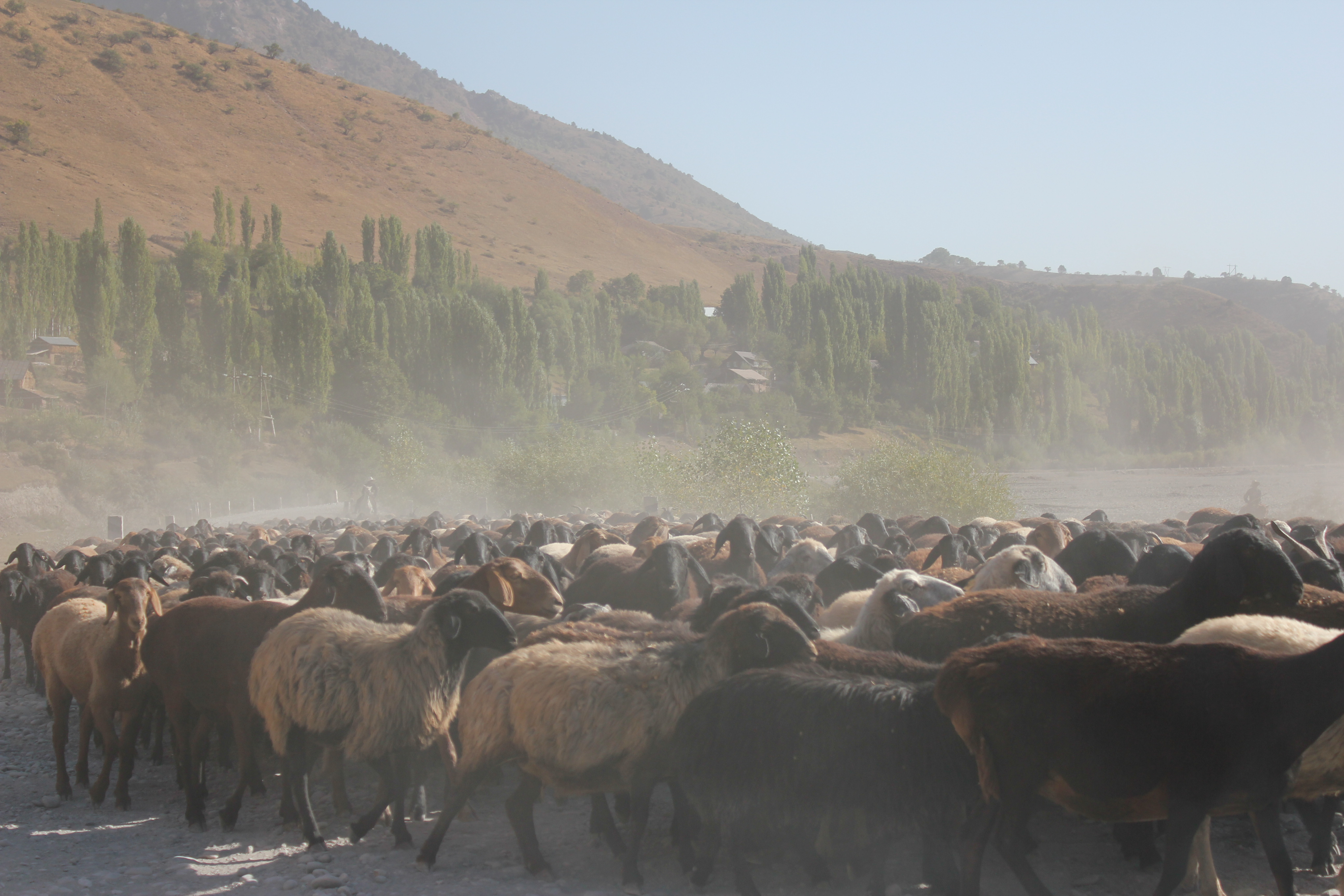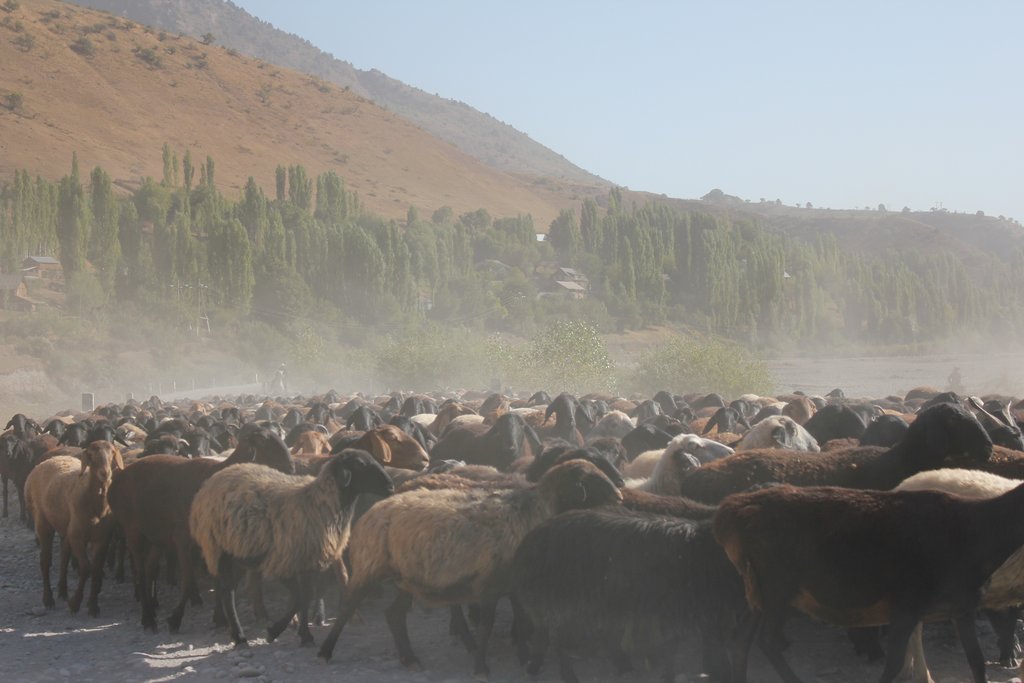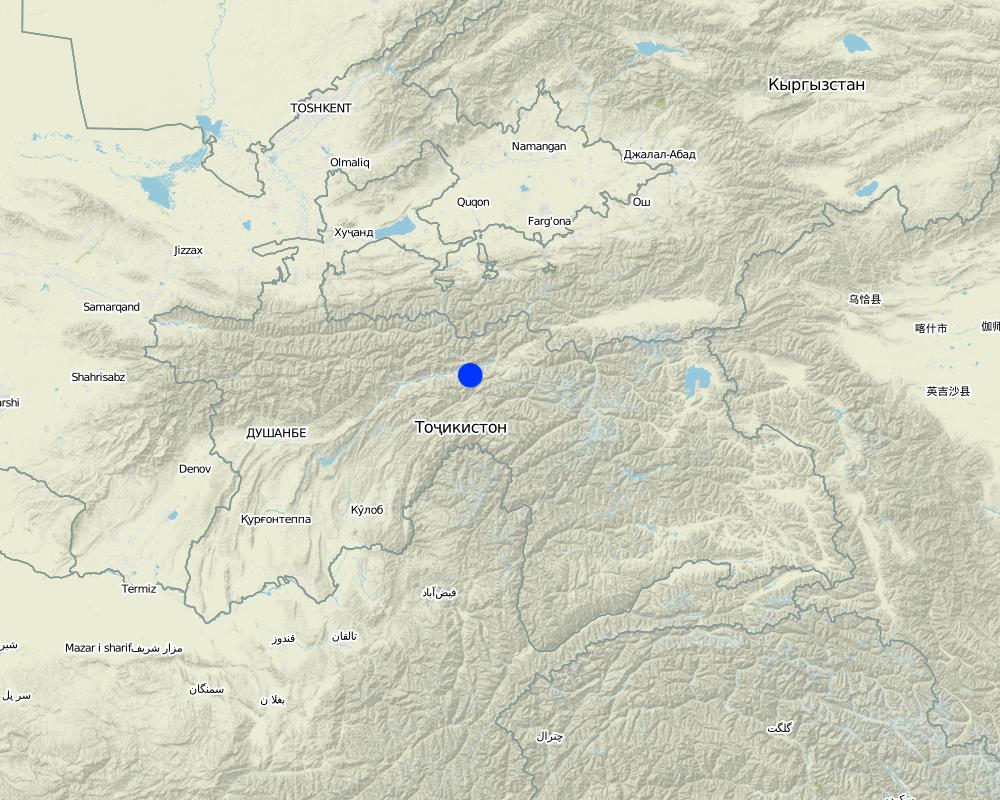Herds movement and roaming at different altitude/watershed zone [塔吉克斯坦]
- 创建:
- 更新:
- 编制者: Askarsho Zevarshoev
- 编辑者: –
- 审查者: Farrukh Nazarmavloev
Бурдани чорво ба чарогоххои дур
approaches_3630 - 塔吉克斯坦
查看章节
全部展开 全部收起1. 一般信息
1.2 参与方法评估和文件编制的资源人员和机构的联系方式
有助于对方法进行记录/评估的项目名称(如相关)
Environmental Land Management and Rural Livelihoods (ELMAR)1.3 关于使用通过WOCAT记录的数据的条件
(现场)数据是什么时候汇编的?:
11/03/2018
编制者和关键资源人员接受有关使用通过WOCAT记录数据的条件。:
是
2. SLM方法的描述
2.1 该方法的简要说明
In this approach community take the opportunity to move their livestock along different pasture resources, which are located at different altitude. This is appropriate in mountains areas, where vegetation period starts in different period and community have access to fresh fodder for their animals. At this time they have the chance to save the pasture close to the village and crop land which they cultivate during summer time.
2.2 该方法的详细说明
该方法的详细说明:
In the mountain areas of Tajikistan pasture are distributed according to the seasonal use named also accordingly – winter/spring pasture and summer pasture. The winter pasture are usually are located in the upper zone of the watershed, while the winter/spring pasture are the one close to the community. Based on this delineation they are used in different season, because in the early spring, when snow just started melting in the close pasture in the remote pasture it is still covered by snow and not possible go to this areas. In this way community provide balance in use of pasture resource between different types of pasture resources along different altitude.
The approach is applied in a participatory way in agreement with all involved stakeholders, including community members/livestock owners, local government and other involved parties, such as herder from other communities. Community jointly in a village meeting in the early season of grazing plan for herds movements and assign responsible people with support of the village management to organize logistics.
Community is very much in favor to organize in such approach to move their animal to other places when at this period they save fodder and easily cultivate their crops land in the village. The only thing they do not like is that during this period they do not have to the dairy product, which could they get from their animals.
2.3 该方法的照片
关于照片的一般说明:
Community build special sheds in the pasture, where the livestock is kept during night time or when there is heavy rainy days. Sometimes, in the remote pasture community build similar but closed, which is also a mean to protect from wild animal, such as bear and wolf and sometime snow leopards.
2.5 采用该方法的国家/地区/地点
国家:
塔吉克斯坦
区域/州/省:
Rasht Vally, Lakhsh District
注释:
The shed, which is called kashar in local language is a traditional approach, which is constructed jointly by community efforts, but sometime external funding also support with construction as part of pasture infrastructure development
Map
×2.6 该方法的开始和终止日期
若不知道准确的年份,请注明该方法的大致开始日期。:
50多年前(传统)
注释:
The approach is traditional way of movement herds along the pasture, while living in mountain communities.
2.7 方法的类型
- 传统/本土
2.8 该方法的主要目的/目标
The main goal of this approach is to balance the availability of pasture resources availalbe for community to gain maximum benefit from existing fodder source in the surrounding areas.
2.9 推动或妨碍实施本办法所适用的技术的条件
社会/文化/宗教规范和价值观
- 启动
this is traditional approach and community members knowledge on this is transferred from generation to generation and does not have any limitation from social/cultural point of view. In fact traditionally the older generation is motivating youth to use the approach in order to use their pasture resource sustainably.
财务资源和服务的可用性/可得性
- 启动
usually not much financial resource is required to implement the resource. The only this is need to organize community and manage their resource sustainably.
机构设置
- 启动
traditional institutions, which deal with natural resource management exist from very beginning. When community motivated to establish their official institutions such as Pasture User Unions this is also enables community to plan according to the approach to move the herd from one pasture area to another during different season.
参与者的的协作/协调
- 启动
traditional all members of community is involved and aware of the approach, and also when official legal institute is established it also bring all stakeholder to plan for pasture grazing in a participatory way
法律框架(土地使用权、土地和水使用权)
- 启动
in a traditional way when applying the approach community know, which part of the pasture they own and plan accordingly, while when the official legal institute is established, such as PUU they obliged to gain certificate, which recognize their land use rights.
土地治理(决策、实施和执行)
- 启动
the approach is discussed in a participatory way among community members and agreed to implement accordingly.
了解SLM,获得技术支持
- 启动
this is traditional knowledge which is transfered from one generation to another generation, however when applied in the framework of project special technical team is assigned to support communities with implementation.
3. 相关利益相关者的参与和角色
3.1 该方法涉及的利益相关者及其职责
- 当地土地使用者/当地社区
community members, livestock owners
support with explaining the approach based on their traditional knowledge and provide evidence based information from their experiences
- 社区组织
village organization, traditional community structures
guide community members and livestock owners on planing and implementing the approach.
- SLM专家/农业顾问
project technical team, specialist from respective research institutes, such as livestock institute
support with applying the technical aspect of the approach and awareness raising on the approach from science point of view.
- 地方政府
respective local government departments, such as land committee, forestry department
supervise the implementation process and guide in applying the approach within framework
3.2 当地土地使用者/当地社区参与该方法的不同阶段
| 当地土地使用者/当地社区的参与 | 指定参与人员并描述活动 | |
|---|---|---|
| 启动/动机 | 自我动员 | traditionally community are used to apply approach every time when the season for grazing comes |
| 计划 | 自我动员 | existing community structure in the mountains areas come together in a community meeting to discuss and develop the plan for pasture use, which entails also applying the approach |
| 实施 | 互动 | usually community organize gathering dates for moving the herd, assign responsible person and agree with other stakeholders or pasture users from neighbor communities. |
| 监测/评估 | 被动 | very passive monitoring is applied in monitoring the approach results and almost no research is involved. |
3.4 有关SLM技术选择的决策
具体说明谁有权决定选择要实施的技术:
- 主要是土地使用者,由SLM专家提供支持
解释:
mainly land users plan for applying the approach, only sometimes when any project implemented in the area the technical team is involved and sometime supported with specialist from local government
明确做出决策的依据:
- 个人经验和意见(无记录)
4. 技术支持、能力建设和知识管理
4.1 能力建设/培训
是否为土地使用者/其他利益相关者提供培训?:
否
4.2 咨询服务
土地使用者有权使用咨询服务吗?:
是
指明是否提供了咨询服务:
- 在土地使用者的土地上
说明/注释:
government officials usually control the movement of the herd to the remote pasture, especially when there is crop season in the village.
4.3 机构强化(组织发展)
是否通过这种方法建立或加强了机构?:
- 是,适度
具体说明机构的强化或建立程度:
- 本地
说明机构、角色和职责、成员等。:
mainly traditional village level structure, which include all community members and leaders to plan for village development. sometime supported by local government to enforce the implementation of the approach in order not to effect the crop production in the village/community.
4.4 监测和评估
监测和评估是该方法的一部分吗?:
是
注释:
very few monitoring is done, usually by the officials of local government from agriculture department to make sure that the livestock is moved to the remote pasture and there is no grazing applied in the crop lands
若是,该文件是否用于监测和评估?:
否
注释:
only reported by the government and from community to the head of the village organization
4.5 研究
研究是该方法的一部分吗?
否
5. 融资和外部物质支持
5.1 该方法中SLM组成部分的年度预算
如果不知道准确的年度预算,请给出一个范围:
- < 2,000
注释(例如主要的资助来源/主要捐助者):
mainly from community of provision of vehicle and other source for infrastructure development, but some projects are also have contributing in construction of the infrastructure, including Environmental Land Management and Rural Livelihoods Project
5.2 为土地使用者提供财政/物质支援
土地使用者是否获得实施该技术的财政/物质支持?:
否
5.3 对特定投入的补贴(包括劳动力)
- 无
如果土地使用者的劳动力是一项重要的投入,那么是不是:
- 自愿
注释:
no construction work is required to implement the approach, only organization and management capacity is needed for community to apply the approach.
5.4 信用
是否根据SLM活动的方法给予信用值?:
否
5.5 其它激励或手段
是否有其他激励措施或工具用于促进SLM技术的实施?:
是
如果是,请具体说明:
development of the community plan, which mobilize and give incentives to implement the approach
6. 影响分析和结论性陈述
6.1 方法的影响
该方法是否有助于当地土地使用者,提高利益相关者的参与度?:
- 否
- 是,很少
- 是,中等
- 是,支持力度很大
it brings all community members, which own livestock and motivate them join management of their resources.
该方法是否建立/加强了机构、利益相关者之间的合作?:
- 否
- 是,很少
- 是,中等
- 是,支持力度很大
while the approach bring all stakeholders together to plan and manage their resource it also strengthens collaboration among them and improves their institutions.
该方法是否缓解了冲突?:
- 否
- 是,很少
- 是,中等
- 是,支持力度很大
the approach enables to agree and communicate the movement of the herd, which does not interfere into the other community areas.
该方法是否有助于社会和经济弱势群体?:
- 否
- 是,很少
- 是,中等
- 是,支持力度很大
the approach is very inclusive and does not discriminate in participation of all groups. Those of who own livestock are equally participate
该方法是否鼓励年轻人/下一代土地使用者参与SLM?:
- 否
- 是,很少
- 是,中等
- 是,支持力度很大
the approach is used to be traditional and both youth and women are involved in promoting and implementing it.
6.2 土地使用者实施SLM的主要动机
- 增加生产
when movement along all the pasture zone is taken place, this will lead burden to other parts and improved productivitiy
- 增加利润(能力),提高成本效益比
research results from other projects shows that movement among different types of pasture create an opportunity to use the potential production of pasture and get maximum increase in livestock productivity
- 减少土地退化
the approach in movement from one part to another place in the pasture leave space for the plot to fallow and regenerate
- 冲突缓解
6.3 方法活动的可持续性
土地使用者能否维持通过该方法实施的措施(无外部支持的情况下)?:
- 是
若是,请说明如何维持:
traditionally the knowledge on the approach is transferred from generation to generation, which guarantees the sustainability, in addition local government is involved to control and supervise the herd movement among different pasture types according to the season.
6.4 该方法的长处/优点
| 土地使用者眼中的长处/优势/机会 |
|---|
| traditional knowledge, simple and effective in livestock management and increasing production |
| 编制者或其他关键资源人员认为的长处/优势/机会 |
|---|
| compliant to the concept of pasture grazing between different areas |
| supported and motivated by government in order to control both the crop production and livestock production |
6.5 该方法的弱点/缺点以及克服它们的方法
| 土地使用者认为的弱点/缺点/风险 | 如何克服它们? |
|---|---|
| when the livestock is moved to remote pasture the owners does not have access or limited access to dairy product | if the pasture infrastructure is well developed it will enable community and also herder to bring the dairy product to the village to sell and process |
| 编制者或其他关键资源人员认为的弱点/缺点/风险 | 如何克服它们? |
|---|---|
| very few monitoring is applied | community capacity should be build to monitor the implementation of the approach |
| research is not involved to recognize the effect of movement | collaboration between communities and research institute to establish and support government to mobilize research institutes |
7. 参考和链接
7.1 方法/信息来源
- 与土地使用者的访谈
various from community to community
- 与SLM专业人员/专家的访谈
3
7.2 参考可用出版物
标题、作者、年份、ISBN:
Pasture and Livestock Management Plan, Askarsho Zevarshoev, 2014
可以从哪里获得?成本如何?
Free, from compiler
链接和模块
全部展开 全部收起链接
无链接
模块
无模块





